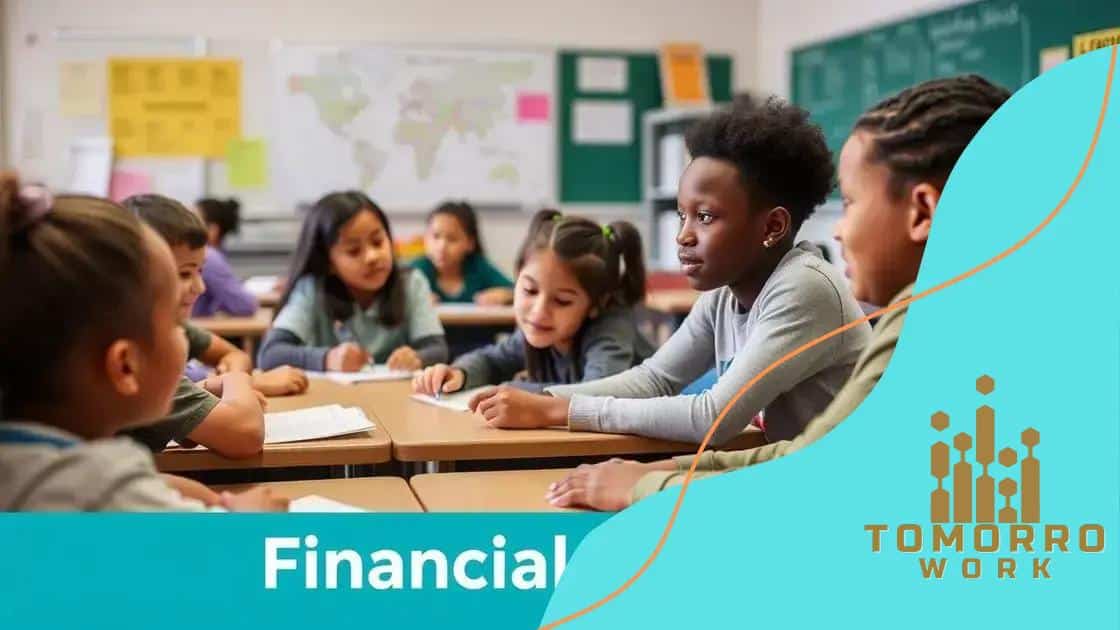How to incorporate financial literacy into high school curricula

Advertisements
Teaching financial literacy in high school curricula prepares students for real-life financial challenges, empowering them with essential skills for managing money, budgeting, and making informed financial decisions.
How to incorporate financial literacy into high school curricula is a pressing question for educators today. Many students leave school without essential financial skills, hindering their future success. Let’s explore ways to fill this gap.
Advertisements
Understanding the basics of financial literacy
Understanding the basics of financial literacy is essential for students, as it forms the foundation for making informed financial decisions. It encompasses a variety of skills that everyone should acquire, starting from budgeting to saving and investing.
What is Financial Literacy?
Financial literacy refers to the ability to understand and use various financial skills effectively. This includes knowing how to manage personal finances, set financial goals, and make sound spending choices.
Key Components of Financial Literacy
- Budgeting: Learning how to create and maintain a budget.
- Saving: Understanding the importance of saving money for future needs.
- Investing: Gaining knowledge about different investment options.
- Debt management: Recognizing how to manage and reduce debt effectively.
Each of these components plays a vital role in a student’s life. By mastering these skills, students are better prepared to handle real-world financial situations. For example, budgeting helps them plan their expenses, while saving encourages them to put money aside for unexpected events.
Advertisements
Moreover, understanding financial literacy also includes knowledge about credit scores and loans. Students should know how credit works and the importance of maintaining a good credit score. This knowledge can prevent them from falling into debt traps in the future.
Why It Matters
The significance of being financially literate cannot be overstated. A lack of knowledge can lead to poor financial decisions, which can have long-lasting impacts on one’s life. By teaching financial literacy in high schools, we empower the next generation to take control of their financial futures.
Incorporating these elements into the curriculum can create a more financially savvy populace. As students learn these basics, they not only enhance their individual lives but also contribute positively to society.
The importance of teaching financial literacy
The importance of teaching financial literacy in high schools cannot be overstated. When students learn about finances early on, they are better equipped to handle their financial responsibilities as adults.
Empowering Students
Teaching financial literacy empowers students to make informed decisions about their money. It allows them to understand the consequences of their financial choices and helps them to create better spending habits.
Real-World Applications
- Budgeting: Students learn how to create and manage a personal budget.
- Investing: Understanding how investments work prepares them for future wealth building.
- Saving: Learning the importance of saving for emergencies and future goals.
- Debt management: Knowledge about loans and credit helps in avoiding pitfalls.
By incorporating these skills into the curriculum, schools can drastically improve the financial health of future generations. For instance, students who understand how to save are likely to accumulate wealth over time, while those who grasp budgeting can avoid unnecessary debt.
Moreover, financial literacy education can spark an interest in economics and finance, opening up potential career paths for students. When they see how financial concepts apply to real life, they engage more deeply in their education.
Long-term Benefits
Understanding financial literacy not only helps students make good choices but also fosters a financially informed community. These individuals grow up to become responsible consumers and caretakers of their own financial future.
In the end, prioritizing financial literacy in education not only benefits the individual but also strengthens the entire economy. By teaching students these critical skills, we prepare them to navigate their financial futures with confidence.
Creative methods to teach financial concepts

Creative methods to teach financial concepts can make learning engaging for students. When students actively participate, they are more likely to grasp the material and retain the information.
Interactive Lessons
One effective way to teach is through interactive lessons. Role-playing games where students simulate real-life financial situations can enhance their understanding. For example, students can act as consumers and sellers to learn about budgeting and negotiation.
Using Technology
- Online simulators can help students practice budgeting.
- Finance apps allow students to manage virtual money.
- Video tutorials can explain complex topics in a fun way.
- Interactive quizzes make learning about finance competitive and enjoyable.
Incorporating technology not only attracts students but also reinforces concepts in a modern context. Gamifying lessons by incorporating apps and online tools enables students to learn at their own pace while providing instant feedback.
Another creative method is to use real-world scenarios. When students analyze current events involving economic changes, they can see the relevance of financial concepts firsthand. Discussions about stock market fluctuations or changes in interest rates can be tied to their personal financial decisions.
Hands-On Projects
Consider engaging students with projects that require budgeting for an event. They can plan a class trip or host a school event, managing costs and resources effectively. This practical application helps them understand the importance of planning and resource allocation.
Bringing in guest speakers from the financial industry can also inspire students. Hearing stories and experiences from professionals can make financial concepts feel more tangible and relatable. Students can ask questions and engage in dialogue, making the learning process interactive.
Integrating real-world examples and tools
Integrating real-world examples and tools into financial literacy lessons can significantly enhance students’ understanding. By relating concepts to their everyday lives, students can better grasp the importance of financial decisions.
Real-World Scenarios
Using real-world examples helps students connect theory to practice. When teachers explain topics like savings accounts or credit scores, including current events or common financial situations makes the lessons more relatable. For instance, discussing how interest rates affect student loans can lead to meaningful conversations about future debt.
Common Tools for Learning
- Finance apps can simulate budgeting and saving scenarios.
- Websites with financial calculators enable students to explore their potential earnings based on different career paths.
- Online platforms offer interactive games that teach investing concepts.
- Virtual reality experiences can place students in real-life financial situations, enhancing their learning.
These tools foster active engagement and build essential skills in an entertaining way. By incorporating technology into lessons, teachers can address various learning styles and keep students interested in financial concepts.
Moreover, field trips to banks or financial institutions help students see how financial systems operate. Learning from professionals in the field allows students to ask questions and gain insights into careers in finance.
Hands-On Activities
Another effective approach is through hands-on activities. For example, students can manage a mock budget for a class event, which teaches planning and accountability. This kind of practical application makes learning about financial literacy both fun and meaningful.
By consistently integrating real-world examples and tools into the curriculum, educators prepare students not just to understand financial concepts but to apply them effectively in their lives. Ultimately, this approach fosters a deeper comprehension of the material and cultivates responsible financial habits.
Evaluating the effectiveness of curricula
Evaluating the effectiveness of financial literacy curricula is essential to ensure students receive the best possible education. By assessing how well these programs prepare students for their financial futures, educators can make necessary adjustments to improve learning outcomes.
Key Metrics for Evaluation
To evaluate a curriculum, it’s important to establish clear metrics. Some of the key metrics include student comprehension, engagement levels, and real-world application of learned concepts. Surveys and standardized tests can provide valuable data on how well students understand financial concepts.
Engagement and Participation
- Monitoring class participation can highlight students’ interest.
- Analyzing attendance rates helps gauge ongoing engagement.
- Feedback from students can offer insights into areas of improvement.
- Creative assignments can be assessed for impact on learning.
Engaging students is crucial for effective learning. Regular feedback sessions give students a voice in their learning experience, making it possible for educators to adapt teaching strategies to better suit their needs.
Additionally, assessing the practical application of skills taught in the curriculum is vital. For instance, do students feel confident budgeting their allowances or understanding credit scores after completing the financial literacy program? Observing students’ capabilities in real-life situations can give educators a clearer picture of the curriculum’s effectiveness.
Longitudinal Studies
Conducting longitudinal studies allows educators to track students’ progress over time. This method can reveal whether the impact of financial literacy education lasts into adulthood. By following up with past students, schools can assess how well the curriculum prepares them for financial responsibilities like managing debts or savings.
Evaluating the effectiveness of financial literacy curricula isn’t just about academic performance; it also emphasizes the overall confidence and competence of students in handling their finances. This ongoing evaluation process ensures that financial education continuously evolves to meet the changing needs of students and society.
FAQ – Frequently Asked Questions about Financial Literacy in High School Curricula
Why is financial literacy important for high school students?
Financial literacy equips students with essential skills to manage their money, make informed financial decisions, and prepare for real-life financial challenges.
What methods can teachers use to make financial literacy engaging?
Teachers can use interactive lessons, real-world scenarios, technology tools, and hands-on activities to engage students effectively in learning financial concepts.
How can financial literacy curricula be evaluated?
Curricula can be evaluated through metrics such as student comprehension, engagement, practical application of skills, and feedback from students.
What are the long-term benefits of financial literacy education?
Financial literacy education helps students become responsible adults who can manage their finances well, ultimately benefiting the economy and society.





